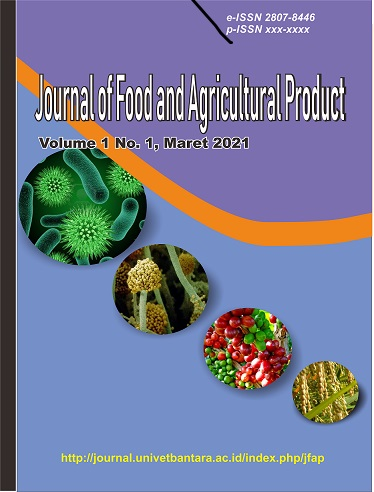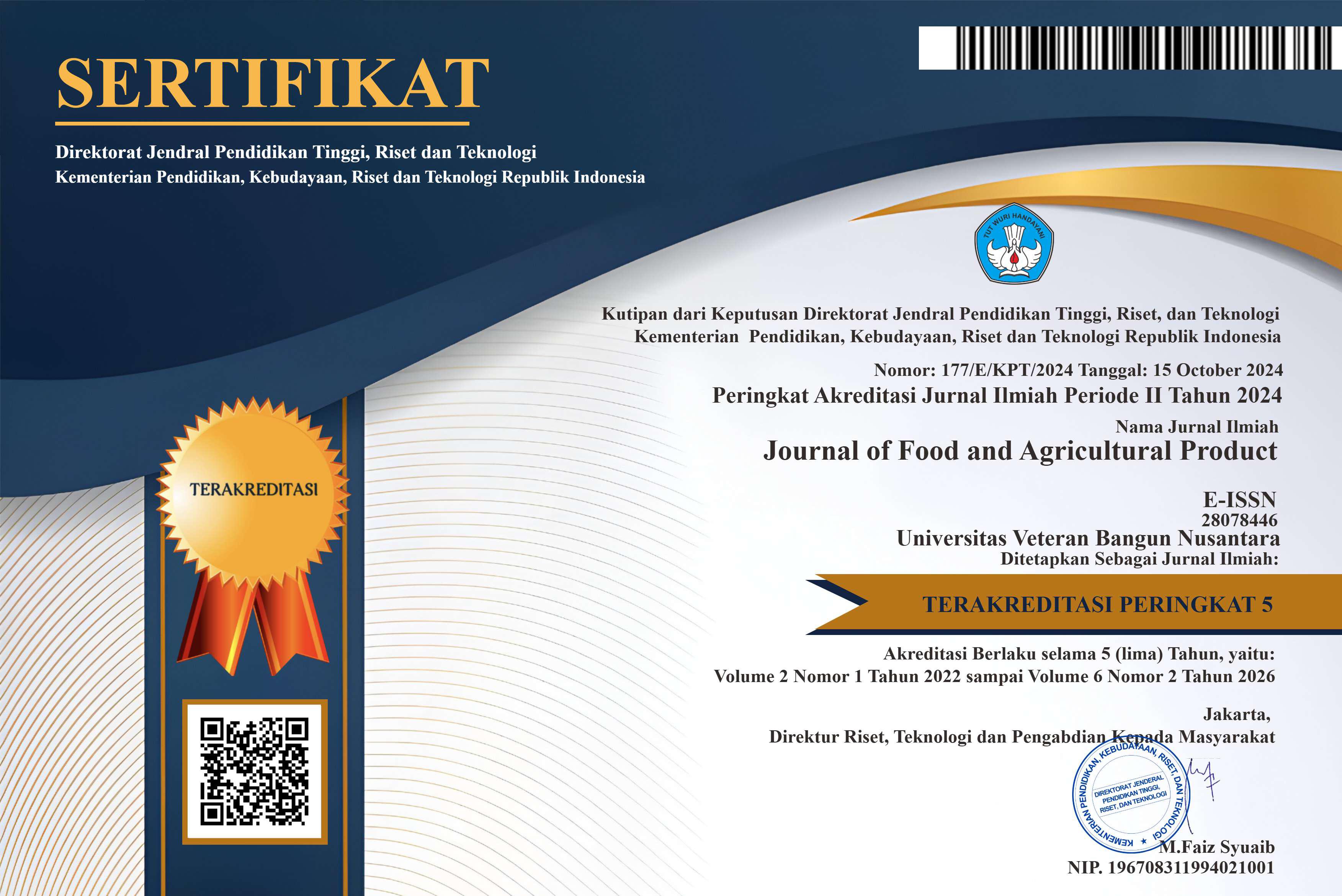Enzymes as Potencial Source for Clean Label Bakery Product: Part 2, Mechanism, Application and Optimization Combination Enzymes
DOI:
https://doi.org/10.32585/jfap.v2i2.2709Abstract
Background: Food enzyme is important ingredient for bakery industry to improve production process, functional properties and characteristic bakery product. Food enzym can be applied as single or combination enzym based on purpose which is need on processing. Based on several literatures, application combination enzymes more effective than single enzym, due to synergism effect between enzym which combine. Combination enzymes can be mixed from same or different class of enzym, it is depended on selected specification and characteristic enzym. Application of combination enzymes commonly act as processing aid which added in flour while mixing process. Therefore, it is important to understand work mechanism of combination enzym in processing stage especially mixing, fermentation and baking. Sinergysm in combination enzym can be enhance using optimization method to improve quality of processing and bakery product. Response Surface Methode (RSM) with Central Composite Design (CCD) as a design experiment is the most effective and efficient method which commonly applied for modelling and optimization in food processing. This method helps to make informed decision on a process with the objective of improving efficiency and minimizing cost while maintaining quality.
Scope and approach: This review explain about the role combination enzyme application in bakery product which discuss under four main headings include (i) Application of combination enzymes in bakery product ii) Mechanism combination enzymes to enhance bakery product quality include processing (mixing, fermentation and baking) and sensory properties (texture, taste, colour and appearance) iii) Optimization of combination enzym in bakery product using Respond Surface Method (RSM) iv) Regulation food enzym usage in United State, Europian Union and Indonesia. Evaluation mechanism, application and optimization of combination enzymes can be used as a base for sustainable development bakery product which is safe for consume and accordance to food regulation. The differences regulation between country can be considerate when supply and distribution chain of industrial and retail food companies stretch around the globe.
Key findings and conclusion: The combination of enzymes provides a synergistic effect depending on the type and mechanism enzymes which is affected each other. Type and mechanism enzymes can be affected with process parameter and ingredient which is a part of food matrix while processing runs. Therefore, the suitability between process parameters, ingredient, specifications and characteristics enzyme are needed to gives significant results for optimization of enzyme combinations in bakery production. Understanding the role of enzymes as a part of food system is important as a basic knowledge in selection of enzymes to be combined. This helps researchers and developers to optimize the combination of enzymes by taking into account conditions of the process stages in bakery production. RSM with CCD as design experiments is the most efficient method because its only requires a small amount runs. CCD uses the build-up principle to build a quadratic model using the information gathered from the 2n factorial design. If the linear model of the 2n factorial is not significant, it is possible to design another trial based on the CCD principle to improve the model. Model improvement using build-up principle is suitable with the food industry needed, which requires fast, precise and accurate validation and verification in making decisions in terms of product development and production process.
Keyword: Combination enzymes, RSM (Response Surface Method), CCD (Central Composite Design), regulation, mechanism, application.
Downloads
References
Abedi, E., Pourmohammadi, K. dan Sayadi, M. 2022. Synergic effect of phytase, amylase, galactosidase, and asparaginase activity on the mitigation of acrylamide and hydroxymethylfurfural in roll bread by co-culture fermentation. Journal of Food Composition and Analysis, 106: 104355.
Alaunyte, I., Valentina, S., Plunkett, A., Ainsworth, P. dan Derbyshire, E. 2012. Improving the quality of nutrient-rich Teff (Eragrostis tef) breads by combination of enzymes in straight dough and sourdough breadmaking. Journal of Cereal Science, 55: 22-30.
Alizadeh-Bahaabadi, G., Lakzadeh, L., Forootanfar, H., dan Akhavan, H. 2022. Optimization of gluten-free bread production with low aflatoxin level based on quinoa flour containing xanthan gum and laccase enzyme. International Journal of Biological Macromolecules, 200: 61–76.
Almeida, E.L. dan Chang, Y.K. 2012. Effect of the addition of enzymes on the quality of frozen pre-baked French bread substituted with whole wheat flour. LWT - Food Science and Technology, 49: 64-72.
Baratto, C.M., Becker, N.B., Gelinski, J.M.L.N. dan Silveira, S.M. 2015. Influence of enzymes and ascorbic acid on dough rheology and wheat bread quality. Afr. J. Biotechnol., 15(3): 55-61.
BPOM RI., 2019. Peraturan Badan Pengawas Obat Dan Makanan Nomor 28 Tahun 2019 Tentang Bahan Penolong Dalam Pengolahan Pangan. Jakarta: BPOM.
Bueno, M.M., Thys, R.C.S. dan Rodrigues, R.C. 2016. Microbial Enzymes as Substitutes of Chemical Additives in Baking Wheat Flour—Part II: Combined Effects of Nine Enzymes on Dough Rheology. Food Bioprocess Technol.
Caballero, P.A., Gomez, M. dan Rosell, C.M. 2007. Improvement of dough rheology, bread quality and bread shelf-life by enzymes combination. Journal of Food Engineering, 81: 42-53.
Di Cagnoa, R., De Angelis, M., Corsettic, A., Lavermicoccab, P., Arnaultd, P., Tossutd, P., Galloa, G., dan Gobbettia, M. 2003. Interactions between sourdough lactic acid bacteria and exogenous enzymes: effects on the microbial kinetics of acidification and dough textural properties. Food Microbiology, 20: 67–75.
Flander, L., Salmenkallio-Marttila, M., Suortti, T. dan Autio, K. 2007. Optimization of ingredients and baking process for improved wholemeal oat bread quality. LWT, 40: 860–870.
Flander, L., Rouau, X., Morel, M., Autio, K., Seppanen-Laakso, T., Kruus, K. dan Buchert, J. 2008. Effects of Laccase and Xylanase on the Chemical and Rheological Properties of Oat and Wheat Doughs. J. Agric. Food Chem., 56: 5732–5742.
Giannone, V., Lauro, M.R., Spina, A., Pasqualone, A., Auditore, L., Puglisi, I., dan Puglisi, G. 2016. A novel a-amylase-lipase formulation as anti – staling agent in durum wheat bread. LWT - Food Science and Technology, 65: 381-389.
Goshima, D., Matsushita, K., Iwata, J., Nakamura, T., Takata, K. dan Yamauchi, H. 2019. Improvement of Bread Dough Supplemented with Crust Gel and the Addition of Optimal Amounts of Bakery Enzymes. Food Science and Technology Research, 25 (5): 625-636.
Hemalathaa, M.S., Leelavathib, K., Salimatha, P.V. dan Prasada Rao, U.J.S. 2014. Control of chapati staling upon treatment of dough with amylases and xylanase. Food Bioscience, 5: 73–84.
Kidane, S.W. 2021. Application of Response Surface Methodology in Food Process Modeling and Optimization. In Response Surface Methodology in Engineering Science. Palanikumar, K. Intech, chapter 13.
Kim, M.J. dan Kim, S.S. 2016. Determination of the Optimum Mixture of Transglutaminase, L-Ascorbic Acid and Xylanase for the Quality and Consumer Acceptability of Bread using Response Surface Methodology. Food Sci. Biotechnol, 25(S): 77-84.
Kim, H. dan Yoo, S. 2020. Effects of Combined α-Amylase and Endo-Xylanase Treatments on the Properties of Fresh and Frozen Doughs and Final Breads. Polymers, 12: 1349.
Kocabas, D.S. dan Grumet, R. 2019. Evolving regulatory policies regarding food enzymes produced by recombinant microorganisms. GM Crops & Food, 10: 191–207.
Kriaa, M., Ouhibi, R., Graba, H., Besbes, S., Jardak, M. dan Kammoun, R. 2015. Synergistic effect of Aspergillus tubingensis CTM 507 glucose oxidase in presence of ascorbic acid and alpha amylase on dough properties, baking quality and shelf life of bread. J Food Sci Technol.
Liu, W., Brennan, M.A., Serventi, L., dan Brennan, C.S. 2017. Effect of cellulase, xylanase and a-amylase combinations on the rheological properties of Chinese steamed bread dough enriched in wheat bran. Food Chemistry, 234: 93–102.
Matouri, M. dan Alemzadeh, I. 2018. Suppressed acrylamide formation during baking in yeast-leavened bread based on added asparaginase, baking time and temperature using response surface methodology. Applied Food Biotechnology, 5 (1): 29-36.
Matsushita, K., Tamura, A., Goshima, D., Santiago, D.M., Myoda, T., Takata, K., dan Yamauchi, H. 2019. Effect of combining additional bakery enzymes and high pressure treatment on bread making qualities. J Food Sci Technol.
Matsushita, K., Tamura, A., Goshima, D., Santiago, D.M., Myoda, T., Takata, K., dan Yamauchi, H. 2019. Optimization of enzymes addition to improve whole wheat bread making quality by response surface methodology and optimization technique. J Food Sci Technol, 56(3): 1454–1461.
McCarthy, D. F., Gallagher, E., Gormley, T.R., Schober, T.J. dan Arendt, E.K. 2005. Application of Response Surface Methodology in the Development of Gluten Free Bread. Cereal Chem., 82(5): 609–615.
Miguel, A.S.M., da Costa F.E.V, Martins-Meyer, T.S dan Dellamora-Ortiz, G.M. 2013. Enzymes in Bakery: Current and Future Trends. In Food Industry. Muzzalo, I (ed.). Intech, 287-321.
Popper, L. dan Losche, K. 2021. Understanding Baking Enzymes. Robert Wenzel. Hamburg, Germany
Sahnoun, M., Kriaa, M., Besbes, S., Jardak, M., Bejar, S., dan Kammoun, R. 2016. Optimization of Aspergillus oryzae S2 α-amylase, ascorbic acid, and glucose oxidase combination for improved French and composite Ukrainian wheat dough properties and bread quality using a mixture design approach. Food Sci. Biotechnol, 25(5): 1291-1298.
Schoenlechner, R., Szatmari, M., Bagdi, A., dan Tomoskozi, S. 2013. Optimisation of bread quality produced from wheat and proso millet (Panicum miliaceum L.) by adding emulsifiers, transglutaminase and xylanase. LWT - Food Science and Technology, 51: 361-366.
Shafisoltani, M., Salehifar, M. dan Hashemi, M. 2014. Effects of enzymatic treatment using Response Surface Methodology on the quality of bread flour. Food Chemistry, 148: 176–183.
Yang, M., Yue, Y., Liu, L., Tong, L., Wang, L., Ashraf, J., Li, N., Zhou, X., dan Zhou, S. 2021. Investigation of combined effects of xylanase and glucose oxidase in whole wheat buns making based on reconstituted model dough system. LWT - Food Science and Technology, 135: 110261.




